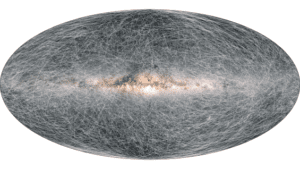
Paris, 8 December 2020. – Mapping the Galaxy in 3D: The European Space Agency (ESA) released millions of new sources and data collected by the Gaia telescope that observes deep space since 2013.
Gaia’s Early third Data Release (EDR3) “contains detailed information on more than 1.8 billion sources, detected by the Gaia spacecraft,” ESA said. “This represents an increase of more than 100 million sources over the previous data release (Gaia DR2), which was made public in April 2018. Gaia EDR3 also contains colour information for around 1.5 billion sources, an increase of about 200 million sources over Gaia DR2. As well as including more sources, the general accuracy and precision of the measurements has also improved.”
The new data allowed astronomers to trace the various populations of older and younger stars out towards the very edge of our galaxy – the galactic anticenter, ESA said. “Computer models predicted that the disc of the Milky Way will grow larger with time as new stars are born. The new data allow us to see the relics of the 10 billion-year-old ancient disc and so determine its smaller extent compared to the Milky Way’s current disc size.”
The Gaia data also strengthen the evidence for another major event in the more recent past of the galaxy, ESA said.





